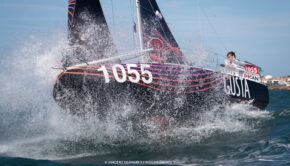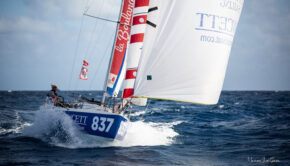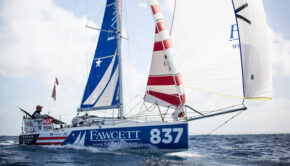Upwind Start for biennial Mini Transat
Published on October 1st, 2017
La Rochelle, France (October 1, 2017) – The weather played a sly hand this morning in the Bassin des Chalutiers. Indeed, the persistent drizzle and low cloud did little to cheer 81 Mini 6.50 sailors preparing to cast off for the biennial Mini Transat, the solo transatlantic race from France to Brazil.
Ultimately though, there was a sense of relief all round that they were finally getting going with their race, a moment they’ve been working towards for the past two years. After a lively start for the first few hours, it promises to be a fine crossing.
As with every Mini-Transat start, the atmosphere is tinged with a mixture of warmth and seriousness on the pontoons and the oppressive grey skies mirror the weight that is on some of their shoulders. On the pontoons, the competitors’ exchanges with their nearest and dearest are muffled.
Faced with an entourage of family and friends, the sailors put up a good show, trying to keep things light with the farewells and the sweet nothings… After all, this Atlantic crossing is a dream that has finally become a reality for many.
Upwind for starters
For all that, the first few miles of this Mini-Transat La Boulangère will be far from restful. With upwind conditions and rough seas plus a substantial south-westerly swell, the solo sailors’ stomachs are likely to be finding things tough this evening.
The focus right now though will be on getting rid of the stress of the start and gradually getting into a more primitive pace of life combining fragmented sleep and snacking rather than meals at set times… Though some will feel at ease almost immediately, others will need two to three days to adapt.
Cape Finisterre, Justice of the Peace
Current predictions suggest that the upwind conditions should be succeeded by some boisterous downwind sailing as the fleet close on Cape Finisterre, according to Christian Dumard, the weather guru from Great Circle.
Essentially, to the south of this headland, the Mini sailors can expect stronger winds in a corridor spanning around a hundred miles offshore of the coast of Galicia and Portugal. As such, the competitors will have to choose between distancing themselves from this corridor, by gaining headway to the west and potentially having to cover extra miles away from the direct route, or hunkering down in a bid to escape the worst of the wind up ahead.
However, the solo sailors aren’t there yet. Between now and the north-west tip of Spain, things could play out in a number of ways.
Minis in the mist
It was in a persistent drizzle that the fleet took today’s start in a W to SW’ly wind of 10 to 15 knots. Almost perfect conditions then, save for the zero visibility in the squalls. Quick out of the starting blocks, the group that opted for the right-hand side of the race zone had the edge. In the prototype category, Erwan Le Méné (Rousseau Clôtures) got the better of Ian Lipinski (Griffon.fr) and Arthur Léopold-Léger (Luna).
Among the production boats, it was a fierce battle between the Pogo 3s, with all the favourites sailing neck and neck. With some slight separation to the right-hand side of the race zone, it was finally Clarisse Crémer (TBS) who was first to tack at the gate that marked the end of the coastal course.
She was followed by Germain Kerlévéo (Astrolabe Expéditions) and Frédéric Moreau (Petit Auguste et Cie); the latter managing to position his Pogo 2 ahead of the pack of Pogo 3s. Before completing the coastal course, Erwan Le Méné, who’d pushed too far on his beat, had to switch back to the mark, allowing Ian Lipinski to snatch back control.
Early return to port
Three competitors are unfortunately having to make a stopover in La Rochelle to effect repairs. The first to announce his return was Fred Guérin (Les-amis.fun), whose hull was holed in a collision with Elodie Pédron (Manu Poki & les Biotecks), she too retracing her steps.
Finally, Gwendal Pibot (Rossinante) announced that he would also be returning to the Port des Minimes after breaking his stay. Obviously, this isn’t the best start to their race, but as was highlighted over the VHF by Tanguy de Lamotte, the skipper of the Imoca60 Initiatives Cœur, who had come along to witness the start, “Making a pitstop is never much fun, but if it has to happen at all then La Rochelle is the least worst option…”
There are still over three weeks of racing to go before the finish in Martinique, which means there’s time to make up their lost ground.
Update
Gwendal Pibot fra599 – rossinante is back in race: back to earth after the departure to change the anchor fitting, always a big help from the ministe community, sleeping the boat, dismantling the damaged room, bringing up the new data gracefully By Marine André, tow by Jean Saucet and his pogo 2 went back to the 80 other ministes!
Corrections
We announced by mistake at the time that Fred Guérin was a victim of a collision with Elodie Pedron. It was Agnes Menut. All our apologies for this false information. Tonight, all the contestants went back: Fred Guérin repaired at sea and Agnes took over the road when she was certain that the skipper of friends. Fun could sail. Gwendal Pibot received an exceptional chain of solidarity which allowed him to go back to the sea at 22 p. M
Class news – Race news – Facebook
Race Facts
· Sunday 1 October: Start of the Mini-Transat La Boulangère in La Rochelle, France
· 21st edition
· 4,050 miles to cover between La Rochelle – Las Palmas in Gran Canaria and Le Marin (Martinique)
· 81 skippers at the start
· 10 women
· 11 nationalities
· 20 years: age of the youngest skipper in the race: Erwan Le Draoulec
· 62 years: age of the oldest skipper in the race: Fred Guérin
· 25 prototypes
· 56 production boats
· 66 rookies
· 15 ‘repeat offenders’
Background
With an overall length of 6.50m and a sail area pushed to the extreme at times, the Mini Class offers incredibly seaworthy boats. Subjected to rather draconian righting tests and equipped with reserve buoyancy making them unsinkable, the boats are capable of posting amazing performances in downwind conditions… most often to the detriment of comfort, which is rudimentary to say the least.
The Mini Transat has two legs to carry the fleet from La Rochelle, France to Martinique, West Indies. The leg from La Rochelle to Las Palmas de Gran Canaria is a perfect introduction to proceedings before taking the big transatlantic leap.
The first leg starts on October 1, with the fleet thrust into the Bay of Biscay which can be tricky to negotiate in autumn, while the dreaded rounding of Cape Finisterre on the north-west tip of Spain marks a kind of prequel to the descent along the coast of Portugal. Statistically, this section involves downwind conditions, often coloured by strong winds and heavy seas. Making landfall in the Canaries requires finesse and highly developed strategic know-how.
The second leg begins on November 1, with the solo sailors most often carried along by the trade wind in what tends to be a little over two weeks at sea on average. At this point, there’s no way out: en route to the West Indies, there are no ports of call. The sailors have to rely entirely upon themselves to make Martinique.
Source: Aurélie BARGAT | Effets Mer









 We’ll keep your information safe.
We’ll keep your information safe.